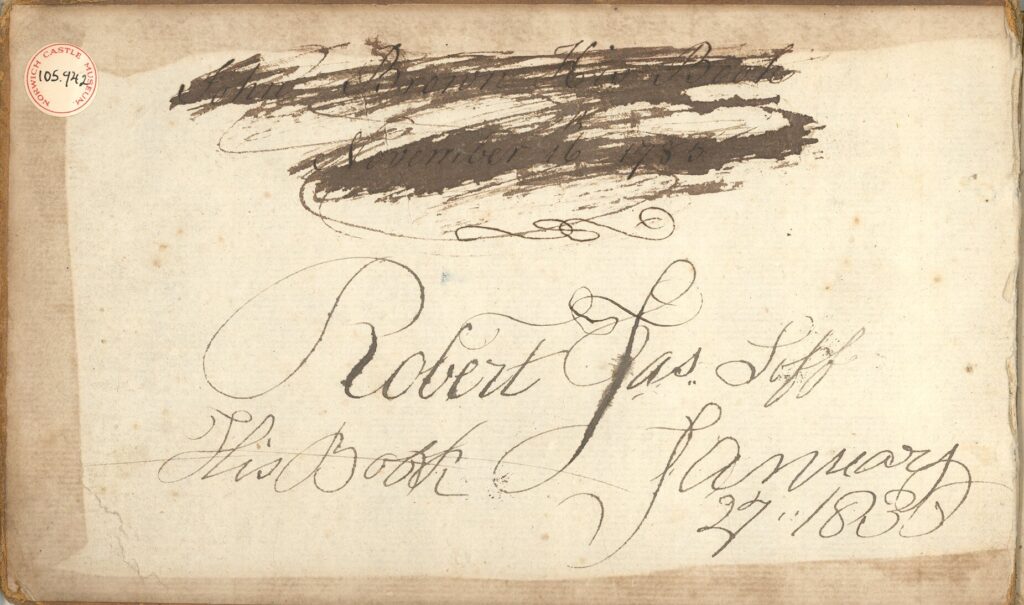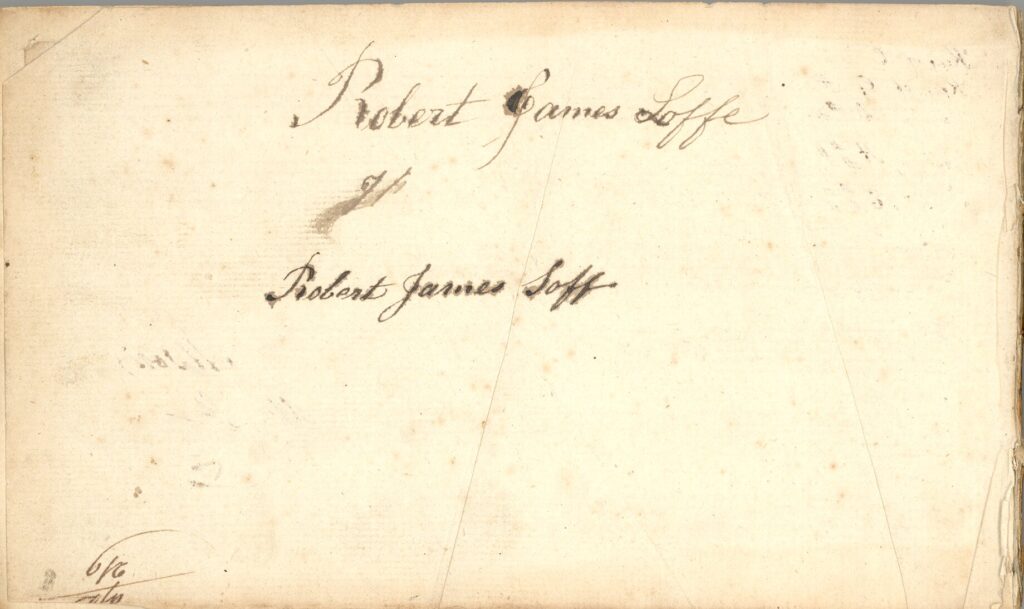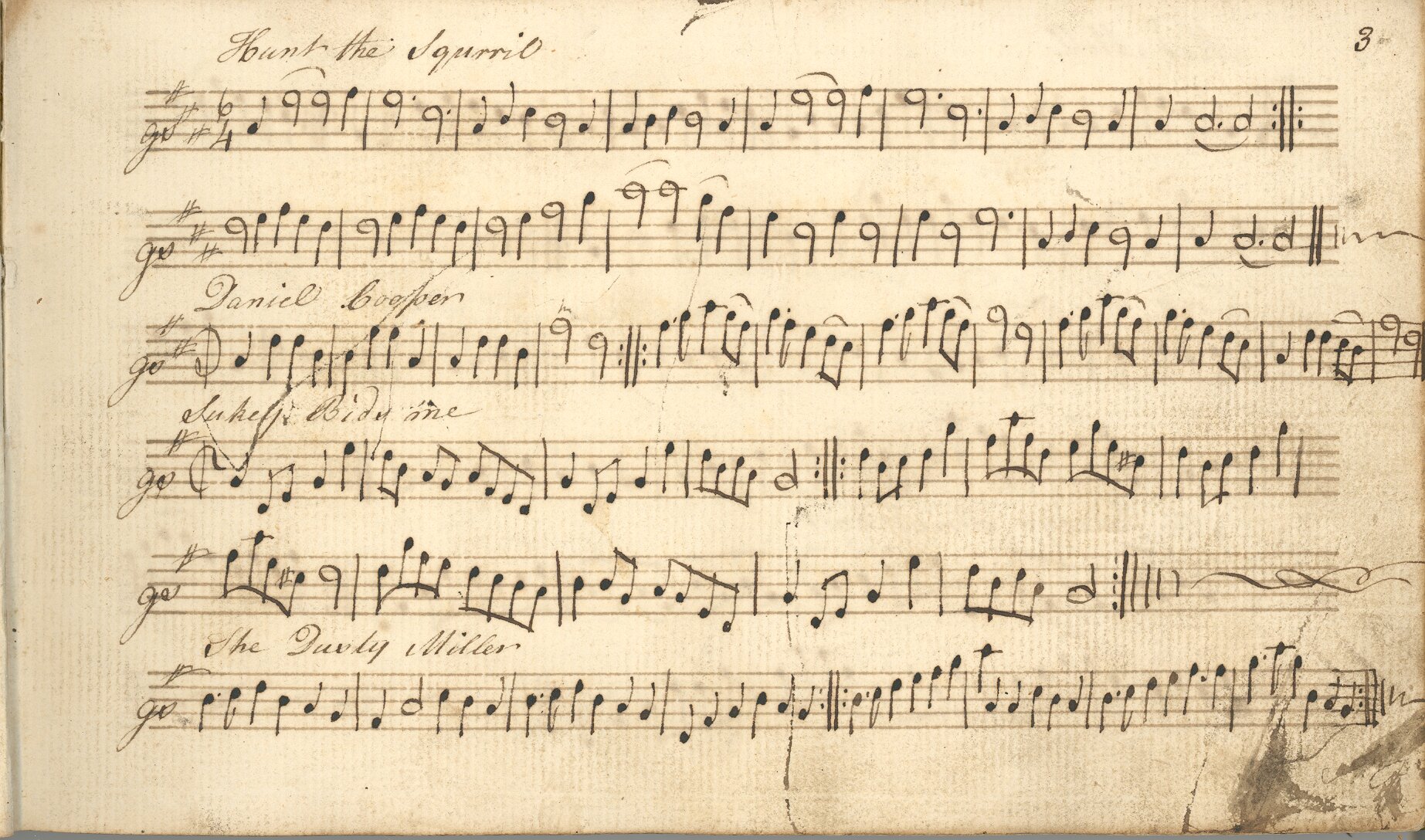(*Following further research, we have now listed this tune book as the Brown-Soffe Tune Book. It has been referred to previously as Goffe and John Brown Tune Books. It may change again – such are the problems with old handwriting!)
March 2021 THIS PAGE IS UNDER CONSTRUCTION – PLEASE BEAR WITH US WHILE WE ADD AND IMPROVE
Research by Alan Helsdon with contributions from Flos Headford, Chris Gutteridge and Cathy Terry from Norfolk Museums
The inclusion of the Brown-Soffe tune book was a 2020 Lockdown project suggested by Norfolk musician, educator and researcher Alan Helsdon. Alan had completed his own research into this tune book before Covid-19 struck and very kindly has passed his findings on to the East Anglian Traditional Music Trust with the view to highlighting this East Anglian resource which is accessible with thanks to the Norfolk museum Strangers’ Hall in Norwich. Alan’s initial research was helped with contributions from another Norfolk musician, Chris Gutteridge.
Since its inclusion on the website (Summer 2020), it has come to the attention of musician Flos Headford (fiddler with the Old Swan Band to name but one) who has worked on several manuscripts – notably as a contributor to the Village Music Project. During November and December 2020, Flos very generously offered to work on this manuscript and has transcribed all of the tunes within this tune book into various formats including ABC notation.
ABC Notation
ABC Notation is a text based music notation system that is fast becoming the go-to notation system for folk and traditional music. It was invented by Chris Walshaw who combined his love of music with his “profound appreciation of computing”.
Over the Spring of 2021, this page will include the ABC versions of the tunes in the Brown tune book. In order to be able to access the .ABC file so that you can read, print and hear the tune, plus read specific notes relating to each tune, you will need to download one of the many ABC FREE software programs. Your first port of call is Chris Walshaw’s comprehensive ABC Notation website where there is much more detail about this notational system with the latest guidelines for the best software.
More than just Dance Tunes
It might be worth noting that we currently have just included the social dance tunes from the Brown-Soffe tune book but there were also hymns included in this book which Flos has kindly also notated in different formats. It is our intention to eventually include these hymns too. Because the hymns are multi voiced, if you do consider downloading the ABC software, you would need to consider this when choosing the appropriate program.
The Book
This original tune book is held at Strangers’ Hall, Norwich (ref NWHCM : 1942 105.2 – Norfolk Museums Service).
The original book is held at Strangers’ Hall, Norwich and on a page at the front are the two owners’ names and dates: ‘John Brown His book November 16 1785’ (crossed out) and ‘Robert Jas G/Soff(e) His book, January 27 1835’. It is this ‘Goff’ that gave the book its name when the research started.


Owners of the manuscript – ‘John Brown His Book November 16 1785’ is crossed out and replaced with ‘Robert Jas G/Soff(e) His Book January 27 1835’ (front of book) and
a slightly tidier signature of Robert James is found at the rear of the book
Credit NWHCM:1942.105.2 Norfolk Museums Service – Strangers’ Hall Museum
Since the involvement of Flos Headford, another suggestion has been made regarding the name Robert Jas Goff. Looking at the pages with the names on, it is ‘Goff’ that is the most debatable. The words ‘Robert Jas’ are fairly clear and Flos queries whether ‘Jas’ is an abbreviated surname of ‘James’. Further towards the end of the tune book Robert James S/Goffe is suggested in the handwriting. The first letter of the final ‘Goff/e’ could be I, S, J or G. Movement in and out of the region was commonplace so it could be that it simply isn’t a common English surname. Another line of enquiry is that ‘Goff’ is actually ‘Suff’ – short for Suffolk. So perhaps, Robert James of Suffolk. For now, in March 2021, we have amended the book title to Brown-Soffe and will keep the title fluid until we have exhausted other lines of enquiries. Anyone reading this article with experience of old manuscripts and hand writing who has any ideas, do please get in touch (info@eatmt.org.uk).
Understandably, when two people are looking at a document which has some information missing, different explanations spring to mind. You can read the musings of both Alan and Flos HERE. What is clear is that within the book tunes are handwritten out but not with the same hand throughout. This is evident even with the dance tunes that are currently just presented on this webpage. John Brown was the first owner so it is reasonable to assume that it was he who filled the first few pages with dance tunes and that it is Robert Jas who possibly filled the remaining tunes. There is a case for assuming that Robert Jas inherited the book in some way and that he continued to play the tunes already in it as well as add material for church services, but it is still John Brown we have to thank for writing out some of the tunes in the first place.

Credit NWHCM:1942.105.2 Norfolk Museums Service – Strangers’ Hall Museum
The manuscripts were originally displayed, surrounded by the instruments of the village it came from, in St Peter Hungate Church. This church was declared redundant in 1936 and was the first church nationally to be repurposed. Until 1995, it was a very popular museum of church art. In 2009, it became the home of Hungate Medieval Art which celebrates Norwich’s medieval heritage and art. There has been a record that this collection exists as part of the Strangers Hall collection since 1942.
When the museum in St Peter Hungate was closed, all the collections were carefully packed and moved to alternative museums storage facilities, including Strangers’ Hall.
Unfortunately the Norwich Museums are currently closed owing to the Covid19 crisis until further notice. Cathy Terry is the senior curator at the museum. All enquiries about this collection should be emailed to Norfolk Museums Service email: museums@norfolk.gov.uk and they will endeavour to answer them at such time as they are able. Please bear in mind this may take longer than usual while the museums are closed.
(Strangers’ Hall Museum, museums@norfolk.gov.uk, Charing Cross, Norwich NR2 4AL. Tel: 01603 667229)
Alan Helsdon, Norwich, May 2020 with additions made with contributions from Flos Headford in February 2021.
The Tunes
The inclusion of the tunes in this tune book will be added in two or three stages. Chris Gutteridge has given Alan a lot of help with the manuscript. The dance tunes are hand-written however and not without missing or dubious notes, missing or odd time and key signatures and ambiguities in pitch and rhythm. Flos Headford has provided downloadable pdfs and sound files of the tunes exactly as written and both Flos and Alan have worked to provide versions which are, above all else, playable. Thanks to Alex of EATMT for the sound files for ear-players and readers alike and also to Cathy Terry, curator of Stranger’s Hall for helping with some of the missing pieces.
There are 31 initial tunes (28 dance tunes) on the first 13 pages of the Brown-Soffe Collection and they are listed alphabetically below. The titles of these tunes have usually been taken from the original collection, so please bear in mind that spelling was flexible.
Click on each tune below which will take you to the relevant page number of the original tunebook. Here you will find a photograph of each page from the tune book plus the tunes that appear on that page. Each tune will offer the original musical notation written in standard notation and abc notation plus a sound file of that original notation. These have been created by Flos. In addition a playable version created by either Alan Helsdon and/or Flos Headford will also be available as a pdf and sound file. These will also be available in abc notation format.*
*These playable versions won’t always be the same version – Alan may have created the pdf playable version with the playable sound file available and Flos may have created his own playable version on ABC notation.
The Bantham/The Pantheon
Blanford Hunt
The Capacheen
Moneys March/Captain Money’s March
Charls Sreet Boulk/Charles Street Bank
Clob March
Daniel Cooper
Death of Ould Robin(g) Gray
Draneon Disk/h
Dublin Volunteer March
Dusty Miller
Easter Holy Day
Faithfull Shepherd
Handel’s Clarinet
Hunt the Squirrel
La Malbrook
Lady Longford’s Reel/Keel
Lady’s Breast Knot
Mad Moll
Money musk
Morgan Ratler/Rattler
Nanacy Dosson/Nancy Dawson
New Daniel Cooper
Rambeer March/Rogues March
Slingsby’s Allemande
Sukey Bids Me
Trip the Landry
Untitled Hornpipe
Ye Social Pow’rs
Opera Dance – This two part dance appears on page 8 of the tune book in between the other dance tunes.
Quick March – Another two part tune appears on page 9 but sadly this is too feint to read
Several tunes have debatable/alternate titles:
‘Charls Sreet Boulk’ is read as Charles Street Bank in the playable sound file and pdf version
‘Draneon Disk’ could be Draner’s Dish or Dirk but is untraceable so far
‘Mad Moll’ is perhaps better known as Yellow Stockings
‘Trip the Landry’ is also known as Trip to the Lawndery
‘Slingsby’s Allemande’ is also known as Aldridge’s Allemande, and appears as such in the collection of William Clarke of Feltwell (you can read more about this collection from Mary Humphreys’ research here.
‘Money’s March’ is Captain Money’s March
‘Rambeer / Rambler March is Rogue’s March
A few seem to have a Scottish influence about them and Alan is investigating that further.
The ABC files from Flos Headford for the first 13 pages of the tune book have been uploaded over the early spring of 2021. The hymns from this tune book will be added over the coming months in ABC format.
Last updated March 2021